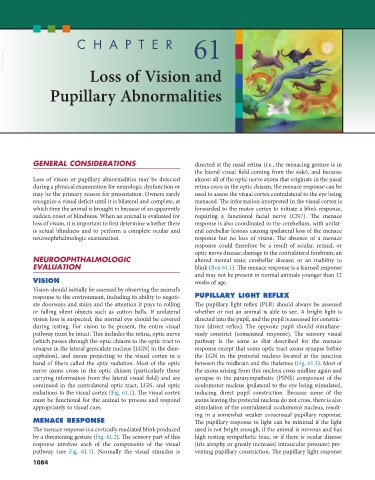Page 1112 - Small Animal Internal Medicine, 6th Edition
P. 1112
1084 PART IX Nervous System and Neuromuscular Disorders
CHAPTER 61
VetBooks.ir
Loss of Vision and
Pupillary Abnormalities
GENERAL CONSIDERATIONS directed at the nasal retina (i.e., the menacing gesture is in
the lateral visual field coming from the side), and because
Loss of vision or pupillary abnormalities may be detected almost all of the optic nerve axons that originate in the nasal
during a physical examination for neurologic dysfunction or retina cross in the optic chiasm, the menace response can be
may be the primary reason for presentation. Owners rarely used to assess the visual cortex contralateral to the eye being
recognize a visual deficit until it is bilateral and complete, at menaced. The information interpreted in the visual cortex is
which time the animal is brought in because of an apparently forwarded to the motor cortex to initiate a blink response,
sudden onset of blindness. When an animal is evaluated for requiring a functional facial nerve (CN7). The menace
loss of vision, it is important to first determine whether there response is also coordinated in the cerebellum, with unilat-
is actual blindness and to perform a complete ocular and eral cerebellar lesions causing ipsilateral loss of the menace
neuroophthalmologic examination. response but no loss of vision. The absence of a menace
response could therefore be a result of ocular, retinal, or
optic nerve disease; damage to the contralateral forebrain; an
NEUROOPHTHALMOLOGIC altered mental state; cerebellar disease; or an inability to
EVALUATION blink (Box 61.1). The menace response is a learned response
and may not be present in normal animals younger than 12
VISION weeks of age.
Vision should initially be assessed by observing the animal’s
response to the environment, including its ability to negoti- PUPILLARY LIGHT REFLEX
ate doorways and stairs and the attention it pays to rolling The pupillary light reflex (PLR) should always be assessed
or falling silent objects such as cotton balls. If unilateral whether or not an animal is able to see. A bright light is
vision loss is suspected, the normal eye should be covered directed into the pupil, and the pupil is assessed for constric-
during testing. For vision to be present, the entire visual tion (direct reflex). The opposite pupil should simultane-
pathway must be intact. This includes the retina, optic nerve ously constrict (consensual response). The sensory visual
(which passes through the optic chiasm to the optic tract to pathway is the same as that described for the menace
synapse in the lateral geniculate nucleus [LGN] in the dien- response except that some optic tract axons synapse before
cephalon), and axons projecting to the visual cortex in a the LGN in the pretectal nucleus located at the junction
band of fibers called the optic radiation. Most of the optic between the midbrain and the thalamus (Fig. 61.3). Most of
nerve axons cross in the optic chiasm (particularly those the axons arising from this nucleus cross midline again and
carrying information from the lateral visual field) and are synapse in the parasympathetic (PSNS) component of the
continued in the contralateral optic tract, LGN, and optic oculomotor nucleus ipsilateral to the eye being stimulated,
radiations to the visual cortex (Fig. 61.1). The visual cortex inducing direct pupil constriction. Because some of the
must be functional for the animal to process and respond axons leaving the pretectal nucleus do not cross, there is also
appropriately to visual cues. stimulation of the contralateral oculomotor nucleus, result-
ing in a somewhat weaker consensual pupillary response.
MENACE RESPONSE The pupillary response to light can be minimal if the light
The menace response is a cortically mediated blink produced used is not bright enough, if the animal is nervous and has
by a threatening gesture (Fig. 61.2). The sensory part of this high resting sympathetic tone, or if there is ocular disease
response involves each of the components of the visual (iris atrophy or greatly increased intraocular pressure) pre-
pathway (see Fig. 61.1). Normally the visual stimulus is venting pupillary constriction. The pupillary light response
1084

